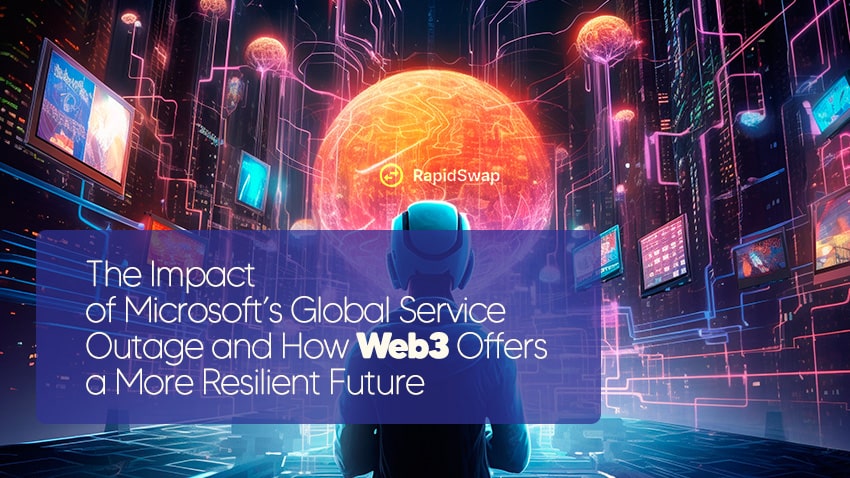The recent global service outage experienced by Microsoft served as a stark reminder of the vulnerabilities inherent in our current internet infrastructure. As businesses and individuals worldwide found themselves disconnected from essential services, the incident highlighted the fragility of centralized systems. This event underscores the need for a more resilient and decentralized approach to digital services—a vision embodied by Web3 technologies. Web3, with its decentralized and blockchain-based architecture, presents a compelling alternative to the traditional web, promising greater security, reliability, and user autonomy.
Understanding the Outage: Centralization’s Achilles’ Heel
Microsoft’s global service outage brought down numerous critical services, including Microsoft 365, Azure, and Teams, leaving millions of users stranded without access to vital tools. The root cause of the outage lay in the centralized nature of Microsoft’s infrastructure, where a single point of failure had a cascading effect on services across the globe. In centralized systems like this, control and management are concentrated in the hands of a few entities, creating a significant risk if something goes wrong.
The outage not only disrupted business operations but also exposed the limitations of relying on centralized systems for essential services. When one part of the network fails, it can lead to widespread disruptions, as seen in this case. The reliance on centralized servers and data centers makes such systems susceptible to technical failures, cyberattacks, and other vulnerabilities, leading to significant downtime and potential data loss.
Web3: A Decentralized Alternative
Web3, often referred to as the decentralized web, offers a solution to the problems highlighted by the Microsoft outage. Unlike Web2, which relies on centralized servers and databases controlled by a few large corporations, Web3 is built on decentralized technologies like blockchain, peer-to-peer networks, and smart contracts. This decentralized architecture eliminates the single point of failure that plagues centralized systems, making Web3 inherently more resilient and secure.
In a Web3 ecosystem, data is distributed across a network of nodes rather than stored in a central location. This means that even if one node goes down, the rest of the network continues to function, ensuring uninterrupted access to services. Additionally, Web3 empowers users by giving them control over their own data, reducing the risk of data breaches and enhancing privacy.
The Benefits of Web3
- Enhanced Resilience and Reliability
Web3’s decentralized nature makes it more resilient to outages and disruptions. Since there is no central point of control, the failure of one node or server does not impact the entire network. This ensures continuous availability of services, even in the face of technical issues or cyberattacks. The Microsoft outage would have had a far less significant impact in a Web3 environment, as the decentralized network would have continued to operate smoothly despite localized failures.
- Increased Security and Privacy
Centralized systems are attractive targets for hackers because they house vast amounts of data in a single location. Web3, on the other hand, distributes data across multiple nodes, making it significantly harder for malicious actors to compromise the entire network. Furthermore, Web3 platforms often use encryption and decentralized identity solutions, providing users with greater control over their personal information and enhancing overall privacy.
- User Empowerment and Ownership
One of the key principles of Web3 is to give users ownership and control over their own data. In the current Web2 model, companies like Microsoft own and control user data, often using it for commercial purposes without the users’ explicit consent. Web3 flips this model by enabling users to store, manage, and share their data on their own terms. This not only enhances privacy but also aligns with the growing demand for digital sovereignty.
- Censorship Resistance
In a centralized system, the controlling entity has the power to censor or restrict access to information and services. Web3’s decentralized infrastructure ensures that no single entity can unilaterally control or censor content, making it a more open and democratic platform. This is particularly important in regions where governments or corporations may seek to limit access to certain information or services.
Challenges and the Road Ahead
While Web3 holds immense promise, it is not without its challenges. The technology is still in its early stages, and widespread adoption will require overcoming significant technical and regulatory hurdles. Issues such as scalability, user experience, and interoperability between different blockchain networks need to be addressed to make Web3 a viable alternative to the current web.
Moreover, transitioning from Web2 to Web3 will require a cultural shift in how users and developers think about the internet. Education and awareness will be crucial in helping people understand the benefits of decentralization and the importance of data ownership.
The Microsoft global service outage was a wake-up call, highlighting the vulnerabilities of our current centralized internet infrastructure. As we become increasingly reliant on digital services, the need for a more resilient, secure, and user-centric web has never been more apparent. Web3 offers a compelling vision for the future—one where power is decentralized, data is secure, and users are in control. While challenges remain, the potential of Web3 to transform our digital lives is undeniable. As the technology continues to evolve, it may very well pave the way for a more robust and equitable internet, ensuring that outages like the one experienced by Microsoft become a thing of the past.

